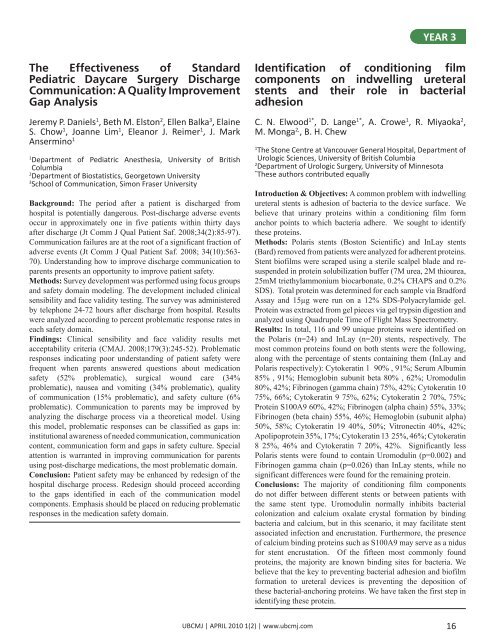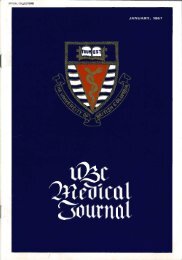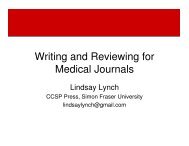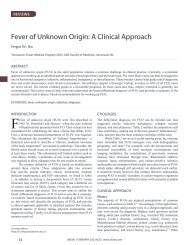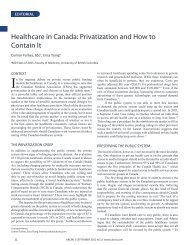Download full PDF - UBC Medical Journal
Download full PDF - UBC Medical Journal
Download full PDF - UBC Medical Journal
Create successful ePaper yourself
Turn your PDF publications into a flip-book with our unique Google optimized e-Paper software.
YEAR 3<br />
The Effectiveness of Standard<br />
Pediatric Daycare Surgery Discharge<br />
Communication: A Quality Improvement<br />
Gap Analysis<br />
Jeremy P. Daniels 1 , Beth M. Elston 2 , Ellen Balka 3 , Elaine<br />
S. Chow 1 , Joanne Lim 1 , Eleanor J. Reimer 1 , J. Mark<br />
Ansermino 1<br />
1<br />
Department of Pediatric Anesthesia, University of British<br />
Columbia<br />
2<br />
Department of Biostatistics, Georgetown University<br />
3<br />
School of Communication, Simon Fraser University<br />
Background: The period after a patient is discharged from<br />
hospital is potentially dangerous. Post-discharge adverse events<br />
occur in approximately one in five patients within thirty days<br />
after discharge (Jt Comm J Qual Patient Saf. 2008;34(2):85-97).<br />
Communication failures are at the root of a significant fraction of<br />
adverse events (Jt Comm J Qual Patient Saf. 2008; 34(10):563-<br />
70). Understanding how to improve discharge communication to<br />
parents presents an opportunity to improve patient safety.<br />
Methods: Survey development was performed using focus groups<br />
and safety domain modeling. The development included clinical<br />
sensibility and face validity testing. The survey was administered<br />
by telephone 24-72 hours after discharge from hospital. Results<br />
were analyzed according to percent problematic response rates in<br />
each safety domain.<br />
Findings: Clinical sensibility and face validity results met<br />
acceptability criteria (CMAJ. 2008;179(3):245-52). Problematic<br />
responses indicating poor understanding of patient safety were<br />
frequent when parents answered questions about medication<br />
safety (52% problematic), surgical wound care (34%<br />
problematic), nausea and vomiting (34% problematic), quality<br />
of communication (15% problematic), and safety culture (6%<br />
problematic). Communication to parents may be improved by<br />
analyzing the discharge process via a theoretical model. Using<br />
this model, problematic responses can be classified as gaps in:<br />
institutional awareness of needed communication, communication<br />
content, communication form and gaps in safety culture. Special<br />
attention is warranted in improving communication for parents<br />
using post-discharge medications, the most problematic domain.<br />
Conclusion: Patient safety may be enhanced by redesign of the<br />
hospital discharge process. Redesign should proceed according<br />
to the gaps identified in each of the communication model<br />
components. Emphasis should be placed on reducing problematic<br />
responses in the medication safety domain.<br />
Identification of conditioning film<br />
components on indwelling ureteral<br />
stents and their role in bacterial<br />
adhesion<br />
C. N. Elwood 1* , D. Lange 1* , A. Crowe 1 , R. Miyaoka 2 ,<br />
M. Monga 2, , B. H. Chew<br />
1<br />
The Stone Centre at Vancouver General Hospital, Department of<br />
Urologic Sciences, University of British Columbia<br />
2<br />
Department of Urologic Surgery, University of Minnesota<br />
*<br />
These authors contributed equally<br />
Introduction & Objectives: A common problem with indwelling<br />
ureteral stents is adhesion of bacteria to the device surface. We<br />
believe that urinary proteins within a conditioning film form<br />
anchor points to which bacteria adhere. We sought to identify<br />
these proteins.<br />
Methods: Polaris stents (Boston Scientific) and InLay stents<br />
(Bard) removed from patients were analyzed for adherent proteins.<br />
Stent biofilms were scraped using a sterile scalpel blade and resuspended<br />
in protein solubilization buffer (7M urea, 2M thiourea,<br />
25mM triethylammonium biocarbonate, 0.2% CHAPS and 0.2%<br />
SDS). Total protein was determined for each sample via Bradford<br />
Assay and 15µg were run on a 12% SDS-Polyacrylamide gel.<br />
Protein was extracted from gel pieces via gel trypsin digestion and<br />
analyzed using Quadrupole Time of Flight Mass Spectrometry.<br />
Results: In total, 116 and 99 unique proteins were identified on<br />
the Polaris (n=24) and InLay (n=20) stents, respectively. The<br />
most common proteins found on both stents were the following,<br />
along with the percentage of stents containing them (InLay and<br />
Polaris respectively): Cytokeratin 1 90% , 91%; Serum Albumin<br />
85% , 91%; Hemoglobin subunit beta 80% , 62%; Uromodulin<br />
80%, 42%; Fibrinogen (gamma chain) 75%, 42%; Cytokeratin 10<br />
75%, 66%; Cytokeratin 9 75%, 62%; Cytokeratin 2 70%, 75%;<br />
Protein S100A9 60%, 42%; Fibrinogen (alpha chain) 55%, 33%;<br />
Fibrinogen (beta chain) 55%, 46%; Hemoglobin (subunit alpha)<br />
50%, 58%; Cytokeratin 19 40%, 50%; Vitronectin 40%, 42%;<br />
Apolipoprotein 35%, 17%; Cytokeratin 13 25%, 46%; Cytokeratin<br />
8 25%, 46% and Cytokeratin 7 20%, 42%. Significantly less<br />
Polaris stents were found to contain Uromodulin (p=0.002) and<br />
Fibrinogen gamma chain (p=0.026) than InLay stents, while no<br />
significant differences were found for the remaining protein.<br />
Conclusions: The majority of conditioning film components<br />
do not differ between different stents or between patients with<br />
the same stent type. Uromodulin normally inhibits bacterial<br />
colonization and calcium oxalate crystal formation by binding<br />
bacteria and calcium, but in this scenario, it may facilitate stent<br />
associated infection and encrustation. Furthermore, the presence<br />
of calcium binding proteins such as S100A9 may serve as a nidus<br />
for stent encrustation. Of the fifteen most commonly found<br />
proteins, the majority are known binding sites for bacteria. We<br />
believe that the key to preventing bacterial adhesion and biofilm<br />
formation to ureteral devices is preventing the deposition of<br />
these bacterial-anchoring proteins. We have taken the first step in<br />
identifying these protein.<br />
<strong>UBC</strong>MJ | APRIL 2010 1(2) | www.ubcmj.com 16


